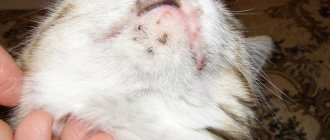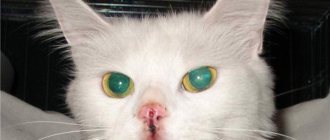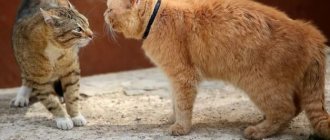Every owner has probably encountered such a nuisance as cat wounds, but not everyone can know about their types and methods of treatment. And this is very important, since with sufficient information you can avoid problems and not aggravate the condition of your pet.
An animal can get wounds both at home and in street fights with other cats or even dogs. And before proceeding with their processing and treatment, it is important to assess their origin, namely size, depth and possibility of infection. First, you should learn about the types of wounds.
How to tell if a cat has wounds
All wounds, regardless of their types, have common symptoms:
- Bleeding to a greater or lesser extent, depending on the type of wound. The most bleeding ones are stabs, cuts and crushed ones.
- The integrity of the skin is compromised. It is difficult to immediately recognize a bite or puncture wound because the entrance hole is very small. This can be done by looking at the cat’s wet fur.
- Lack of fur in a certain area.
- Presence of edema.
- Painful sensations, during which the animal behaves restlessly and often licks the place where the wound appeared.
With complicated wounds, redness around the lesion, suppuration, increased temperature, and even the development of an abscess can be observed.
In cats, purulent, open and lacerated wounds most often occur. But regardless of their size and whether the cat can be treated at home or you will have to seek help from a veterinarian, you will need to treat the wound by first shaving the hair around it. It is recommended to give preference to safe chlorhexidine for treating wounds rather than iodine or brilliant green, which can cause burns to the skin and internal tissues. It is also necessary to free the wound from foreign objects, and then apply a sterile bandage. If treatment is neglected, pathogenic bacteria will enter the wound and suppuration cannot be avoided. And in this case, more serious and lengthy treatment will be required.
Do I need to treat or will it heal on its own?
The opinion that everything heals quickly on cats because they lick their wounds is wrong. Even small injuries can develop into serious wounds if not treated promptly. Damage often occurs due to the action of dirty objects, which can cause infection.
What to give your cat for diarrhea at home
If a cat has a fight with another pet and there are wounds from the teeth, they quickly become crusty. Upon examination, it appears that the surface is healing and the damage is not dangerous. However, when bitten, the teeth penetrate into the deep layers of the skin, which is dangerous for infection. The top layer may heal within a few days, but the microbes that get inside begin to multiply.
Important! The infection quickly spreads throughout the body, and the wounds fill with pus. If left untreated, necrosis and blood poisoning may develop.
Treatment at home for a purulent wound
Purulent wounds in cats can be open or closed. It is good when the wound is open, since pus can flow freely from it. It is worse when the wound is closed and has turned into an abscess - a cavity with an accumulation of pus.
You can identify a festering wound yourself. There will not only be swelling and pain in the cat, but also pus will leak if the wound is open or an abscess will appear if it is closed. The cat may also have a fever and the temperature will rise.
The veterinarian may prescribe a microbiological examination for the animal, for which pus is taken from the wound at its maximum depth.
As for treating a purulent wound in a cat, the method is selected depending on whether it is open or closed. In any case, the wound is cleaned of dead tissue, all accumulated pus is removed from it, and its outflow is ensured. A bandage is applied with wound healing ointment.
With an abscess everything is more complicated. It will be necessary to open it, and then install a drainage to ensure the free removal of pus from the wound, as well as to prevent the cat’s wound from re-healing. It is better if this manipulation is carried out by a veterinarian in a clinic, and then the owner will have to care for the wound and treat it at home.
How are purulent wounds treated on cats? An antiseptic solution and regular dressings with a wound-healing ointment, such as Levomekol, are well suited for washing. A veterinarian should monitor the wound healing process.
Along with these medications, it is recommended to give the cat an antibiotic according to the regimen prescribed by a specialist, and painkillers to relieve pain.
Wound healing drugs
Used for significant lesions and purulent processes. In demand:
- Dioxicol.
- Ribonuclease.
- Trypsin.
- Ciminal.
- Iruksol.
- Solcoseryl.
Dioxicol is used externally in the form of powder or ointment.
Ribonuclease. The enzyme preparation destroys the RNA of pathogenic microorganisms that interfere with wound healing. Used in ointment form.
Trypsin is a powdered digestive enzyme preparation that promotes the decomposition of purulent masses.
Ciminal. It has an antiseptic and epithelializing effect. Used in the form of powder.
Iruksol is an ointment that contains an enzyme preparation that cleanses the wound surface of pus and necrotic textures. Does not affect healthy tissue and granulations.
Solcoseryl. Wet surfaces are treated with a gel form of the drug, dried surfaces with an ointment form.
A recovering cat must be provided with adequate nutrition - commercially produced food.
What to do, details...
I want to warn you right away that my cats are free, village animals. They spend most of their time outdoors. And therefore they have much more strength and energy than domestic cats, starved by the city. This means that it is somewhat easier for them to restore their health. So. After a two-day absence, my cat arrived with a stale wound on his side, covered with some kind of film, and exuding a terrible smell of rotting. Everyone thought he would die. I made him a spacious soft bed in the boiler room, with water, food and a toilet. That is, complete boxing. Then she began to wash the wound with hydrogen peroxide. Peroxide was poured onto the wound, and the leaking excess was wiped with a clean rag. At the same time, the peroxide hissed and foamed. The cat, of course, resisted at first and had to be held. The film that closed the wound turned out to be purulent, and for good reason it had to be cut off immediately, so it would be easier to wash the wound. But this was not a pleasant sight and of course I would never have decided to cut it. I washed the wound with peroxide for two days, as often as I could.
If the wound is clean, after washing it can be anesthetized with novocaine by simply pouring the contents of the ampoule onto it. And of course you need to give an antibiotic, calculating the dose based on the weight of the animal; this is less than the child’s dose.
By the end of the second day, the wound had cleared and the muscles were visible. They were not damaged or inflamed, which could not but rejoice; they had a delicate color, like rabbit meat. That is, a large piece of skin was torn out from the side of the animal, five or six centimeters in diameter, without deeper damage. For good measure, this wound had to be stitched up, which of course I couldn’t do. Therefore, I sprinkled streptocide powder on the wound, it helps wounds heal. Some of the powder immediately dried on the wound, some was licked off by the cat. After the pus has been removed, there is no need to rinse with peroxide unless you see new pus formation. Over the next week, I sprinkled streptocide on the wound once or twice a day. By the end of the week, my freedom-loving cat could not stand the isolation and slipped outside. There, of course, he had a good roll in the ground. Came in the evening, with dirt on the wound. I didn't touch him anymore. I was just monitoring the situation. But everything was fine. Walks and earthen baths did him good. The cat pulled himself up, and the wound also began to shrink, shrinking before our eyes. Within a month, the wound had healed to the size of a small sore. Throughout the illness, the animal ate excellent food, and after two days of treatment, it stopped resisting. Moreover, while this large wound was healing, he managed to get a huge number of smaller ones. If I missed something, ask me, I’ll tell you what I know.
Every owner has probably encountered such a nuisance as cat wounds, but not everyone can know about their types and methods of treatment.
And this is very important, since having sufficient information you can avoid problems and not aggravate the condition of your pet
An animal can get wounds both at home and in street fights with other cats or even dogs.
And before proceeding with their processing and treatment, it is important to assess their origin, namely size, depth and possibility of infection. First you need to learn about the types of wounds
Wounds, depending on what injury caused them, are divided into:
- torn;
- bruised;
- bitten;
- crushed;
- cut;
- chopped;
- scalped.
But all wounds are divided not only into types. They can also be complicated or uncomplicated. The former are subject to infection and the development of subsequent suppuration, the latter proceed without anything.
What to do if your head wound is festering
If a cat has a festering wound on its head, all manipulations to eliminate suppuration should be carried out very carefully. First you need to free the surface near the wound from hair and dried pus. The wool is cut and the crusts are soaked in 3% hydrogen peroxide. Under no circumstances should they be scraped off or the pus squeezed out. And do not put your hands into the wound, so as not to aggravate your pet’s condition. If foreign objects are found in the wound, carefully remove them with tweezers. There is no need to touch the remaining skin around the edges of the wound; take the cat to the vet as is. And if he deems it necessary, he will delete them himself.
Zelenka is more gentle and gentle as an antiseptic than iodine.
The main advantage is that brilliant green does not dry out the skin, it is better suited for large and pinpoint damaged surfaces, suppurations, various types of infections, it prevents the flow of lymph and moisture to the wound. Based on this information, it should be concluded that iodine should be put away in case of open bleeding. The main thing is not to forget that if you receive serious injuries, you should never self-medicate, but should consult a doctor. Another interesting fact about the effects of brilliant green antiseptics is that it found its most widespread use on the territory of the Soviet Union. In other countries, it was simply never used for these purposes.
Various studies in the field of medicine indicate the ability of brilliant green to fight Staphylococcus aureus, streptococcus, and the fungus Candida albicans, but it is practically useless against gram-negative bacteria, where its effectiveness has not yet been proven. Apparently, the mechanism of action of brilliant green is somehow connected with the destruction of the cell wall, characteristic of gram-positive microorganisms.
The line between the use of brilliant green and iodine is very thin, and surgical instruments are also treated with both. It is not recommended to fill the wound with iodine solution: the irritating effect of the injured skin will only make it worse. Hydrogen peroxide is sometimes used as an alternative when treating injuries.
In any case, almost everyone should have iodine and brilliant green in their first aid kit.
Treatment at home for an open wound
Treatment of open wounds on a cat begins with the generally accepted principles of treatment, namely by cleansing them of dirt, debris and all foreign bodies. And only then is treatment with an antiseptic drug carried out.
Its subsequent healing depends on how correct the treatment of an open wound is. Excellent antiseptics are chlorhexidine, fucorcin and furatsilin. They are safe and do not cause burns upon contact with the affected area.
Open wounds should not be treated with iodine, brilliant green and alcohol-containing preparations, as they can aggravate the condition of the wound, causing a chemical burn. They are only suitable for treating the skin around the wound.
If your pet has an open wound, first aid should be provided by a veterinarian, because very often the wound needs to be sutured. But if more than twelve hours have passed since the injury, then suturing is no longer done.
Cat care
A cat that has wounds should receive maximum care and peace of mind until complete recovery.
. During this period, it is advisable to protect the animal from contact with other pets, as well as from visits to the street. Do not allow the animal to lick or scratch the wound, bandage or stitches, or tear the damaged area. To ensure that the wound has the opportunity to dry out and the cat cannot tear it, you can put on a special collar.
The bandage should always be clean and dry, and it should be changed in accordance with the recommendations of a specialist at the veterinary emergency center. At the first stage, this can happen 2-3 times a day, and then less often. It all depends on how quickly the wound heals and its complexity.
A fairly important part of the rehabilitation process when a wound occurs in cats is the pet’s nutrition. Food must be balanced so that the body receives a sufficient amount of nutrients and can actively fight infection. You should not feed your animal food that is irritating. These products include smoked meats, sausages, and various sweets. The diet should contain a sufficient amount of vegetables and nutrients that will increase the level of the immune system. The veterinarian at the Ya-VET emergency center can prescribe vitamin complexes to improve the general condition of the animal.
How to treat a wound on a cat with bleeding
If a cat is injured and has bleeding, you need to act differently, depending on what part of the body was injured:
- If there is bleeding from a wound on the paw, apply a tourniquet immediately. It can be made from a bandage, tape, rope, fabric or rubber tape, bandaging the paw above the wound. If the bleeding has not stopped, then it is venous, and a tourniquet must be applied below the wound. An alternative to a tourniquet can be a cotton-gauze bandage soaked in a vinegar solution, which is applied to the wound for several days.
- If there is bleeding on the neck or torso, the wound must be covered with a napkin or gauze soaked in a herbal decoction of calendula, coltsfoot or chamomile and a tight bandage must be made, but so that the cat can breathe normally.
- If there is bleeding in the peritoneum, you should not give the animal water, but after bandaging it, apply a cold compress to the abdomen. If the bleeding is accompanied by vomiting blood or if it is in the lungs, the cat should be given cold water, but not fed.
Wounds from opening a breast tumor
If a cat eats and drinks normally and leads a normal life, owners do not always decide to euthanize it if it has breast cancer. However, after opening the tumor, wounds are formed that gradually increase in size.
Opened tumor in a cat
Oncological ulcers are treated with Levomekol or similar external agents:
- Sulfargin is an ointment containing silver sulfadiazine. The substance counteracts gram-positive and gram-negative bacteria. When released, metal ions exhibit long-lasting antimicrobial and bactericidal effects. The product does not have necrolytic or mutagenic properties.
- Solcoseryl is an ointment based on a deproteinized hemoderivative obtained from calf blood. The ointment supplies phosphates to tissues, increases the use of oxygen and the supply of glucose to cells, improves repair, promotes collagen formation and reduces secondary degeneration in damaged structures.
The drug is prescribed by a veterinarian.
The affected area is first treated with antiseptic drugs. These are solutions of chlorhexidine (0.5%), furatsilin (1%), potassium permanganate (2–5%). Ulcers and tumors are also washed with a sterile isotonic or saline solution (sodium chloride solution in water 2–5%). The latter is used for infusions and is also sold in pharmacies. Ointments are used after drying the wound.
Wounds are washed with saline solution
Timely treatment of wounds will prevent the appearance of an unpleasant putrefactive odor, which always accompanies opened tumors.
How to treat if the wound does not heal on the paw
It happens that a cat has injured its paw and quite some time has passed, but the wound still does not heal. In this case, it is imperative to treat it with medications so as not to lead to severe infection. Sometimes a similar situation occurs when suppuration begins. Treatment will be required for disinfection three times a day and only then wound healing.
It is very important not to allow the cat to lick the wound, because he may thereby lead himself to repeated suppuration. To do this, cover the wound with a sterile bandage and seal it with a plaster. And you should definitely take your pet to the vet. In especially severe cases, it is impossible to do without laser irradiation of the wound, injections of antibiotics, special vitamins and food to promote its speedy healing. The main thing is to understand the seriousness of the cat’s injury and treat it responsibly.











